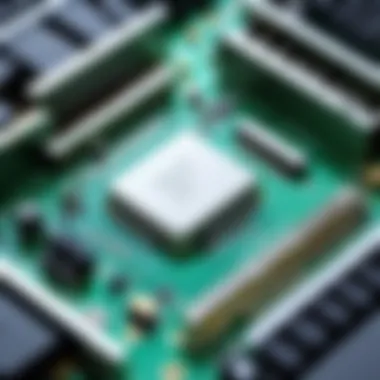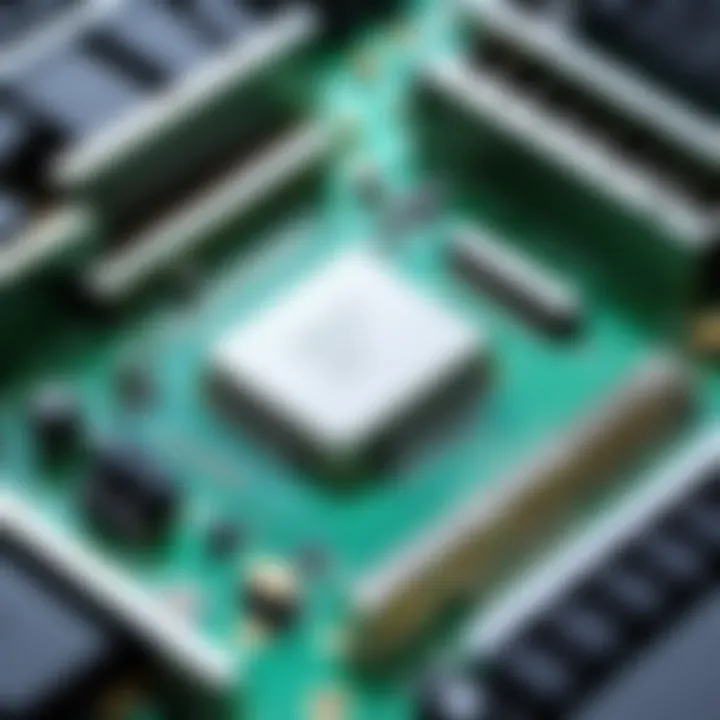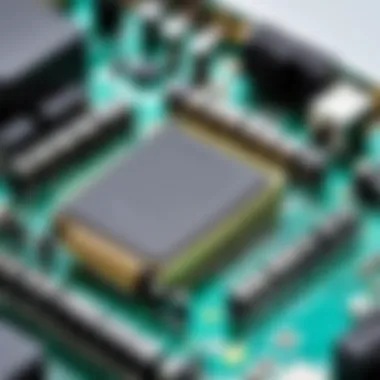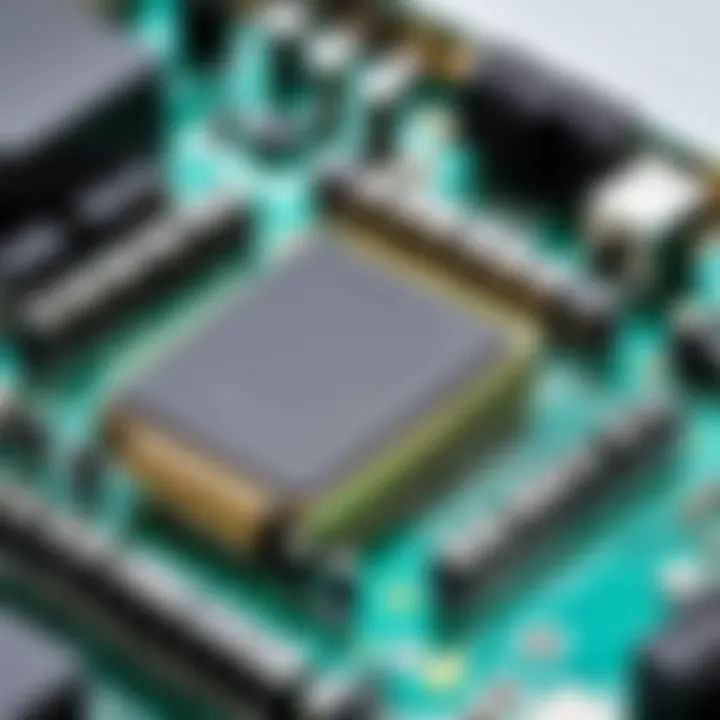Understanding Ethernet Controllers in Modern Networking


Intro
In the dynamic landscape of modern networking, Ethernet controllers serve as foundational elements that ensure efficient data transmission. Their significance cannot be overstated, as they bridge the gap between hardware and the digital data we access daily. Understanding how these controllers operate and their various types is essential for tech enthusiasts and professionals alike. This exploration goes beyond mere technical specifications, delving into the complex interactions and emerging technologies that define Ethernet controllers today.
Product Overview
Ethernet controllers come in different forms, each catering to specific networking needs. They typically consist of several key components, including the Media Access Control (MAC) interface and the physical layer transceiver. Various brands produce Ethernet controllers, including Intel, Broadcom, and Realtek. Each brand offers unique specifications that can impact their performance in different scenarios.
- Brand Information
- Key Specifications:
Specifications often highlight speed (e.g., 1GbE, 10GbE), support for advanced features like virtualization, and power consumption metrics. - Pricing:
Pricing can vary widely based on performance and application. Budget controllers may start at around $10, while high-performance models can exceed $100.
- Intel: Known for its high-performance chips, Intel Ethernet controllers are integral in enterprise-grade solutions.
- Broadcom: Offers a range of controllers suitable for data centers and high-speed networking.
- Realtek: Popular for budget-friendly solutions, often found in consumer-grade devices.
Performance Comparison
To evaluate Ethernet controllers, performance metrics are crucial. Benchmark tests provide a means to compare their capabilities effectively.
Benchmark Tests
Through testing across various conditions, we can observe differences in latency, throughput, and reliability. Tools such as iPerf and LANBench can help perform these tests.
Speed and Efficiency Comparisons
- Controllers like Intel's I210 are known for their low latency and high throughput.
- Broadcom's BCM5720 excels in data centers, supporting multiple virtual machines without performance drop.
Features and Technology
Advancements in Ethernet controller technology have led to features that enhance usability and efficiency.
- Unique Features:
Controllers now often include offloading capabilities to reduce CPU burden and support for Power over Ethernet (PoE). - Technological Advancements:
Innovations such as increased data throughput and lower power consumption are critical. For instance, 25GbE and 100GbE technologies are gaining traction in high-bandwidth networks. - Compatibility with Other Devices:
Being adaptable with various networking devices, Ethernet controllers usually support standard protocols, ensuring seamless integration with switches, routers, and servers.
Pros and Cons
Before choosing an Ethernet controller, understanding their advantages and drawbacks is essential.
- Strengths of the Product:
- Areas for Improvement:
- High data throughput and low latency improve performance.
- Compatibility with existing infrastructure saves costs during upgrades.
- Some lower-end models may not support advanced features like virtualization.
- Limited availability of drivers can hinder usage in specific operating systems.
Value for Money
Assessing whether an Ethernet controller offers value necessitates examining its cost-effectiveness and long-term benefits.
- Cost-effectiveness:
When considering the initial outlay, one should weigh it against potential performance gains and decreased operational costs. - Long-term Benefits:
A reliable controller can enhance network stability and reduce future costs related to upgrades and maintenance. - Comparison with Similar Products:
Evaluating like-for-like against competitors, especially in terms of performance and features, plays a vital role in deciding which controller to invest in.
Ethernet controllers not only facilitate network communication but also significantly influence overall network performance and reliability.
Through this overview, it becomes clear that Ethernet controllers are central to modern networking, impacting how data is processed and transmitted across devices.
Prelude to Ethernet Controllers
Ethernet controllers are critical components in modern networking infrastructure. They bridge the gap between network devices and the communication channels that connect them. Understanding Ethernet controllers is essential for anyone involved in networking, from tech enthusiasts to IT professionals.
The significance of Ethernet controllers stems from their role in enabling reliable data transmission across networks. As organizations increasingly rely on high-speed connections to support a multitude of applications, the need for efficient Ethernet controllers is more pressing than ever. This section will provide a foundational understanding necessary for grasping advanced concepts in Ethernet technology.
Definition and Overview
An Ethernet controller is a hardware device that facilitates network communication within Ethernet-based networks. It operates at various layers of the OSI model, primarily functioning in the data link layer. Ethernet controllers manage the processing, transmission, and reception of data packets, ensuring smooth and efficient functionality. These devices often integrate multiple features, such as buffering and protocol support, to enhance network performance.
Typical Ethernet controllers can be standalone chips or part of integrated circuits. Their design includes circuitry that governs how data is transmitted over network links. This specialized hardware is crucial for converting digital data from a computer into signals that can be sent across a network.
Purpose in Networking
The primary purpose of Ethernet controllers is to enable devices to communicate over a network effectively. As technology evolves, the demand for faster and more efficient Ethernet connections continues to grow. Ethernet controllers facilitate this by managing data flow, minimizing errors, and ensuring data integrity.
Key functions include:
- Packet processing: This involves encapsulating data into packets and managing the transmission of these packets through the network.
- Error detection: Controllers implement mechanisms to detect corrupted packets and request retransmission, enhancing reliability.
- Speed management: Many modern Ethernet controllers support various data rates, accommodating different types of network infrastructure.
To comprehend the advancements in networking, it is essential to appreciate how Ethernet controllers contribute to scalability and performance enhancements across varied applications. As the backbone of many networks, their development directly impacts communication speeds and overall user experience.
"Ethernet controllers are not merely supporting components; they are the architects of seamless network communication."
In summary, Ethernet controllers serve as fundamental tools in ensuring that modern networks operate efficiently. Their critical functions encompass a wide array of aspects that support the increasing demands of today's digital communications.
Key Features of Ethernet Controllers
Understanding Ethernet controllers involves recognizing their key features. These elements are vital in defining the capabilities and performance of these devices in modern networking environments. By focusing on the specific characteristics like data transfer speeds, protocol support, and interface types, one can appreciate how they contribute to efficient data communication.
Data Transfer Speeds
Data transfer speed is a critical consideration when evaluating Ethernet controllers. Faster speeds lead to improved network performance, enabling quick data transfer between devices. The evolution from Fast Ethernet to Gigabit and even 10Gb Ethernet reflects this trend. Higher speeds reduce bottlenecks, especially in environments handling large data volumes, such as data centers. Users often prioritize these speeds to maintain responsive applications and seamless connectivity, particularly with the rise of high-bandwidth activities like streaming and gaming.
Protocol Support
Protocol support is another essential feature of Ethernet controllers. Different networking environments require compatibility with various protocols. Modern Ethernet controllers support a range of standards, including IEEE 802.3, a critical requirement for network interoperability. With proper protocol support, Ethernet controllers can efficiently communicate with diverse devices, ensuring seamless data exchange and minimizing connectivity issues. This flexibility is crucial for businesses that utilize mixed-media networking environments.


Interface Types
The interface type of an Ethernet controller determines how it connects to a network and other peripherals. Several types of interfaces have gained prominence in the industry:
PCI Express
PCI Express, or PCIe, is widely regarded for its high data transfer rates and internal integration capabilities. This interface supports multiple lanes for data transmission, providing considerable bandwidth for high-performance applications. Its scalability allows manufacturers to design flexible solutions that adapt to various performance needs. A key advantage of PCIe is its low latency, essential for performance-sensitive applications. Additionally, devices equipped with PCIe can easily be upgraded as technology advances.
USB Ethernet
USB Ethernet adapters are increasingly common, especially in consumer electronics. The ease of use and plug-and-play nature of USB makes it a favored choice for users who seek to connect devices simply. USB Ethernet controllers provide sufficient bandwidth for tasks typically encountered in home and small office setups. However, their limitations become apparent in high-performance environments, as they may not support the same speeds as PCIe based solutions.
Integrated Solutions
Integrated solutions refer to Ethernet controllers built directly into devices such as motherboards and network cards. This design approach simplifies the architecture and improves the reliability of the hardware. Integrated solutions often consume less power and reduce the need for additional components. Though they may lack the flexibility of standalone controllers, they usually provide adequate performance for average networking requirements. Their popularity stems from compactness and efficiency, particularly in embedded systems.
The key features of Ethernet controllers highlight their essential role in ensuring reliable and rapid network communication. As networking needs evolve, understanding these features becomes increasingly important for tech enthusiasts and professionals.
Types of Ethernet Controllers
The landscape of Ethernet controllers is intricate and varied, consisting of several types, each designed to address specific networking scenarios. Understanding these types is crucial for tech enthusiasts and professionals who aim to optimize their networking solutions. Each class provides unique capabilities, features, and advantages that influence performance, integration, and application across environments. A thorough knowledge of this topic helps in selecting the appropriate controller for a given requirement, aligning functionality with expected outcomes.
Wired Ethernet Controllers
Wired Ethernet controllers are the backbone of most Ethernet networking scenarios. They enable reliable and high-speed connections in various applications, from data centers to small office networks. These controllers typically utilize physical connections through Ethernet cables, which result in more stable performance compared to wireless alternatives.
Benefits of Wired Ethernet Controllers:
- Stability: Wired connections tend to experience less interference from environmental factors, offering consistent performance.
- Speed: Generally, wired Ethernet controllers support higher data transfer rates than their wireless counterparts. This is particularly important for bandwidth-intensive tasks, such as video streaming or large file transfers.
- Security: It is harder for unauthorized users to access wired networks, making them a preferred choice for critical applications where data integrity is crucial.
Despite their advantages, wired Ethernet controllers do require physical cabling and management of those cables. This can complicate installations in some environments, but the trade-off is often worth it for the performance gains realized.
Wireless Ethernet Controllers
Wireless Ethernet controllers stand out for their ability to connect devices without the need for cable infrastructure. This category has grown significantly, driven by the demand for mobility and convenience in various settings, such as homes, offices, and public places. Wireless Ethernet technologies, including Wi-Fi, allow multiple devices to connect to the network without being tethered to a specific location.
Considerations for Wireless Ethernet Controllers:
- Flexibility: Devices can connect from greater distances without the limitations of physical cabling, making them ideal for mobile setups.
- Ease of Installation: Setting up a wireless network generally requires less labor and can be more convenient than installing wired solutions.
- Upgradability: As technology advances, upgrading a wireless network often means simply updating firmware or settings instead of replacing cables.
On the downside, wireless networks can face issues with interference, signal degradation, and potential security vulnerabilities. Balancing these aspects is essential for effective integration in specific environments.
Management Ethernet Controllers
Management Ethernet controllers serve a specialized function by integrating advanced features for network management. These controllers often include capabilities such as traffic monitoring, Quality of Service (QoS) features, and enhanced diagnostics. They are particularly relevant in enterprise networks where maintaining optimal performance and ensuring security are critical.
Key Functions of Management Ethernet Controllers:
- Traffic Management: These controllers can prioritize certain types of network traffic to ensure that critical applications receive the necessary bandwidth, which is vital in environments with varying data needs.
- Monitoring and Diagnostics: Advanced monitoring allows network administrators to quickly troubleshoot issues and assess performance, enhancing overall reliability.
- Scalability: Management controllers are often designed to handle growth in network demand, supporting additional devices and higher throughput as necessary.
Components of an Ethernet Controller
The components of an Ethernet Controller play a crucial role in its functionality and effectiveness within networking systems. These parts are designed to facilitate communication between devices and ensure data transfer occurs smoothly. Understanding these components helps professionals recognize how each piece contributes to overall network performance, reliability, and efficiency.
Physical Layer Interfaces
Physical Layer Interfaces are foundational in Ethernet controllers. They deal with the actual transmission of data across physical mediums. Ethernet typically transmits data using twisted pair cables or fiber optics, where the interface must effectively convert digital data into electrical signals and vice versa. This conversion is vital because it allows devices to communicate across different distances and mediums.
Each type of cable has different specifications, such as distance limitations and bandwidth capabilities. For instance, Category 6a cables support speeds up to 10Gbps for distances up to 100 meters. Understanding the specifications of these interfaces ensures that the right choice is made for specific networking needs, affecting performance significantly.
Data Link Layer Processing
Data Link Layer Processing is another key element in the operation of Ethernet controllers. This component is responsible for framing the data packets that traverse the network. It accomplishes framing by adding headers and trailers to the packets, which contain vital information for addressing and integrity checking. This ensures that packets reach their intended destination without errors.
In modern networking, protocols such as IEEE 802.3 govern how Ethernet handles these frames. Efficient data link layer processing is essential because it directly impacts latency and throughput. If the processing is slow, it might introduce delays in communication, hindering performance especially in environments requiring real-time data transfer, such as gaming or video streaming.
Buffer Management Systems
Buffer Management Systems within Ethernet controllers are essential for handling bursts of data traffic. These systems temporarily store incoming packets to manage differences between the rate of incoming and outgoing data. High-performance networking environments often encounter sudden influxes of data; having an effective buffering strategy is crucial to prevent packet loss.
Buffers are classified mainly into input and output buffers. Input buffers hold incoming data before forwarding it to processing units, while output buffers manage outgoing data before it leaves the device. If buffers are too small, packets may be dropped, causing latency issues and reduced overall network efficiency.
"Buffer management is a key aspect that can determine how well an Ethernet controller performs under high load conditions."
By understanding these components, tech enthusiasts, gamers, and IT professionals can better appreciate how Ethernet controllers function within broader networking contexts. This not only aids in selecting the appropriate technology but also highlights areas for improvement and optimization in existing network setups.
Performance Metrics for Ethernet Controllers
The performance metrics for Ethernet controllers play a vital role in evaluating their efficiency and effectiveness within networking environments. These metrics provide insights into parameters such as data handling capabilities, responsiveness, and overall reliability. When assessing Ethernet controllers, understanding these performance indicators is essential for making informed decisions regarding network infrastructure. Factors like throughput rates, latency, and packet loss are key to ensuring optimal operation in various settings, from corporate networks to data centers.
Throughput Rates
Throughput rates refer to the amount of data that can be transmitted successfully over the network in a given time period. This measurement is crucial for determining the capability of Ethernet controllers to handle large volumes of data. High throughput rates are necessary for applications that require fast data transfers, such as video streaming or online gaming.
In practical terms, the throughput of Ethernet controllers is often influenced by several factors:
- Bandwidth: The higher the bandwidth, the higher the potential throughput. For instance, a Gigabit Ethernet controller can theoretically handle 1 Gbps under ideal conditions.
- Network Congestion: Traffic levels on the network can cause fluctuations in throughput, making it important to monitor and manage overall network traffic.
- Protocol Overhead: Different networking protocols have varying levels of overhead that can affect the actual data throughput.


Evaluating throughput rates helps in selecting the right Ethernet controllers depending on your specific bandwidth needs and usage scenarios.
Latency
Latency is another critical performance metric that reflects the delay experienced in data transmission. It is often measured in milliseconds (ms) and can significantly impact user experience, especially in real-time applications such as VoIP or online gaming. Low latency is desired to ensure prompt communication between devices.
Several factors can contribute to latency in Ethernet networks:
- Propagation Delay: This is the time it takes for a signal to travel across the physical medium. Different distances and media types can affect this.
- Processing Delay: Inherent delays caused by devices processing data packets can accumulate, impacting overall latency.
- Queueing Delay: During periods of high traffic, packets may need to wait in queues before being processed, which adds to the latency.
Optimizing latency is essential for maintaining efficient network performance, particularly for applications where responsiveness is critical.
Packet Loss and Error Rates
Packet loss and error rates are additional performance parameters that indicate the reliability of Ethernet controllers. Packet loss occurs when one or more packets of data traveling across a network fail to reach their destination. This can lead to decreased performance and can significantly disrupt application functionality.
Understanding the causes of packet loss involves examination of factors like:
- Network Congestion: As previously mentioned, high traffic can lead to packet loss if buffers overflow.
- Signal Interference: In wireless setups, interference from other devices can cause packets to be lost during transmission.
- Faulty Hardware: Malfunctioning network equipment can also be a source of errors leading to packet loss.
Measuring error rates is crucial for maintaining the integrity of data communication. Selecting Ethernet controllers with low packet loss rates is particularly important for critical applications where data integrity is non-negotiable.
"Monitoring performance metrics enables businesses to proactively manage their networking needs, ensuring efficiency and reliability in a rapidly evolving technological landscape."
Overall, analyzing these performance metrics provides a comprehensive understanding of what to expect from Ethernet controllers, assisting network designers and IT professionals in optimizing performance to meet specific demands.
Ethernet Controller Technologies
Ethernet controller technologies represent a pivotal aspect of modern networking systems. As data transmission needs evolve, the demand for more efficient and scalable Ethernet solutions continues to grow. Understanding these technologies is crucial in adapting to increasingly bandwidth-hungry applications. From Gigabit Ethernet to emerging 100Gb solutions, each technology presents unique features and efficiencies that influence performance and usability in various environments.
Gigabit Ethernet Controllers
Gigabit Ethernet controllers have established themselves as the standard for networking since their introduction. Operating at speeds of 1 Gbps, these controllers are fundamental for both consumer and enterprise levels. They provide sufficient bandwidth for typical applications such as streaming and web browsing.
The architecture of Gigabit Ethernet controllers allows for full-duplex communication. This means that data can be sent and received simultaneously, enhancing efficiency. Additionally, they often support various physical media, including twisted pair and fiber optics, making them versatile.
- Benefits:
- Cost-effective for mass adoption.
- Compatible with legacy systems, ensuring smooth transitions.
- Energy-efficient designs for reduced operational costs.
10Gb Ethernet Controllers
As data demands continue to rise, 10Gb Ethernet controllers have emerged to address higher throughput requirements. With a tenfold increase in speed over Gigabit, these controllers are designed for applications like data centers and high-performance computing.
The growth of cloud services and virtualization has similarly driven the need for 10Gb solutions, as more efficient data transfer becomes necessary. These controllers facilitate rapid data transfers, reducing bottlenecks that can hinder performance.
Key features include:
- Multi-rate support: Many 10Gb controllers can auto-negotiate between various speeds, ensuring adaptability.
- Reduced latency: These controllers optimize packet processing, which is vital for time-sensitive applications.
- Increased copper options: With innovations like Category 6a cables, 10Gb solutions can be cost-effective in certain setups.
Emerging 25Gb and 100Gb Solutions
The advent of 25Gb and 100Gb Ethernet technologies reflects the networking industry's response to exponential data growth. These solutions are aimed at high-density environments, such as large-scale data centers and cloud services.
25Gb Ethernet offers a practical balance between cost and performance. It is particularly effective in applications that require rapid data transfers without significant investment in infrastructure. Additionally, its compatibility with existing 10Gb equipment eases the upgrade pathway.
On the other hand, 100Gb Ethernet is geared towards the highest performance requirements, enabling ultra-fast data transfers. It is best suited for organizations that manage massive amounts of data and rely on instantaneous access.
"The shift towards higher data rates is not just about speed; it’s about redefining the capabilities of networking to support next-generation applications."
These advanced Ethernet technologies play a significant role in shaping modern networks, addressing both scalability and efficiency challenges. As networks evolve, the integration of these solutions will be vital to maintaining robust performance and reliability.
Applications of Ethernet Controllers
Ethernet controllers have become a cornerstone in the realm of networking, finding applications across various sectors. The importance of understanding these applications lies in recognizing how Ethernet technology enhances functionality, efficiency, and performance in today’s increasingly connected world. The following subsections will detail specific domains where Ethernet controllers are utilized, providing insights into their essential roles and benefits.
Data Centers
Data centers are at the heart of modern computing and internet infrastructure. They rely heavily on Ethernet controllers to manage the vast amounts of data traffic generated by thousands of users and applications. The efficiency of Ethernet controllers influences throughput and the ability to handle concurrent requests. As demands for speed and reliability increase, Gigabit Ethernet controllers and 10Gb solutions have become prevalent, ensuring that data can flow seamlessly.
With the rise of cloud computing and big data, Ethernet controllers also play a crucial role in facilitating low latency communication. They allow data center operators to optimize resources, leading to reduced operational costs and improved user experiences. The ability to scale operations is another significant benefit, allowing data centers to expand their systems without necessitating major overhauls. Data centers equipped with advanced Ethernet controllers can maintain performance consistency under high loads.
Enterprise Networks
In enterprise environments, Ethernet controllers serve a central function in maintaining robust, stable, and secure networks. Companies leverage these controllers to connect various devices, such as computers, printers, and VoIP phones, to ensure that their operations run smoothly. The flexibility of Ethernet technology means that businesses can adapt their network infrastructure to changing needs without extensive reconfiguration.
Furthermore, Ethernet controllers enhance overall network reliability and security. Features such as VLAN support and QoS management enable enterprises to configure their networks to prioritize critical applications and ensure that sensitive data is managed with care. The implementation of Power over Ethernet (PoE) technology allows devices to receive both power and data over a single cable, reducing clutter and improving installation efficiency.
Embedded Systems
Embedded systems often incorporate Ethernet controllers to facilitate communication and data exchange between units. From smart home devices to industrial automation systems, Ethernet technology provides a standardized way to connect components. The integration of Ethernet controllers in these systems allows for real-time monitoring and communication, which is vital for operational continuity.
Manufacturers increasingly favor Ethernet in embedded systems due to its robustness, scalability, and ability to support a range of protocols. This versatility allows for easier interoperability across different devices and systems. Moreover, as the Internet of Things (IoT) continues to expand, the role of Ethernet controllers in embedded systems will only grow. They enable efficient data transfer for analysis and decision-making processes, which is crucial in a data-driven environment.
"As the demand for connectivity increases, Ethernet controllers will become indispensable to various applications across sectors, ensuring effective communication and data management."
Through these applications, it is evident that Ethernet controllers are not just additionals to networking; they are pivotal in driving performance, adaptability, and innovation across diverse fields.


Impact of Ethernet Controllers on Networking
Ethernet controllers serve as essential components of networking environments today. Their functionality greatly influences the overall performance and efficiency of network systems. This section examines the impacts of Ethernet controllers on networking by evaluating how they enhance performance, promote scalability, and contribute to cost-effectiveness.
Network Performance Enhancements
Ethernet controllers directly contribute to network performance. They facilitate high-speed data transfer, enabling devices to communicate effectively in real-time. Key performance indicators, such as throughput and latency, are significantly influenced by these controllers. Higher throughput rates allow more data to be processed simultaneously, benefiting applications requiring extensive bandwidth. Furthermore, advancements in Ethernet technology have led to reduced latency, making interactions between devices swifter. This becomes evident in applications like online gaming or video conferencing, where every millisecond counts.
Another important aspect is traffic management features inherent in modern Ethernet controllers. These features prioritize essential data packets, ensuring crucial information reaches its destination without delay or loss. Thus, network performance is consistently optimized.
Scalability Improvements
Scalability is another critical advantage provided by Ethernet controllers. As networks expand, they must maintain performance without degradation. Ethernet controllers support this need through their ability to handle increased data loads seamlessly. They can efficiently manage the addition of new devices, distributing network traffic evenly.
Additionally, the versatility of Ethernet technology allows for integration with various devices, making incremental upgrades straightforward. Businesses can increase their network capacity with minimal disruption. Particularly in enterprise settings, where user demands fluctuate, Ethernet controllers adaptively scale resources to maintain optimal performance.
Cost-Effectiveness
From a financial perspective, Ethernet controllers also provide notable cost advantages. They enable companies to optimize their existing infrastructure, reducing the need for major overhauls. Organizations can often achieve performance improvements by simply upgrading controllers rather than replacing entire networking frameworks.
This cost-effectiveness is amplified by the long lifespan and durability of Ethernet technology. Investing in high-quality Ethernet controllers can yield savings over time, lessening hardware replacement costs and minimizing downtime. In turn, effective budget management becomes paramount for organizations striving for a balance between performance and expenditure.
Therefore, Ethernet controllers play a pivotal role in enhancing network performance, scalability, and cost-effectiveness, making them invaluable to modern networking environments.
Challenges with Ethernet Controllers
Ethernet controllers are essential for modern networking, enabling seamless communication between devices. However, they face several challenges that can impact their performance and reliability. Understanding these challenges is key for individuals and organizations looking to optimize their network solutions.
Interoperability Issues
One significant challenge is ensuring interoperability among different Ethernet controllers. Networks often comprise devices from various manufacturers, each using distinct technologies and protocols. This diversity can lead to compatibility issues, causing disruptions in communication and efficiency. For instance, a wired Ethernet controller may not work seamlessly with a wireless counterpart if they utilize different communication standards.
To mitigate these issues, it is crucial for manufacturers to adhere to established standards, such as those set by the IEEE. Also, rigorous testing before deployment can identify potential incompatibilities. This careful approach ensures that devices can effectively communicate.
Power Consumption
Power consumption is another important challenge faced by Ethernet controllers. As networks continue to evolve, the demand for energy-efficient solutions grows. Many devices require constant connectivity, which can increase power usage, impacting operational costs and environmental sustainability.
To address this, manufacturers are exploring low-power designs and implementing technologies like Energy Efficient Ethernet (EEE). Such advancements aim to reduce power consumption during idle times while maintaining performance during active use. By focusing on energy efficiency, organizations can minimize expenses and promote sustainability in their networks.
Future Development Challenges
Looking ahead, Ethernet controllers face several development challenges that could shape their future. One of these is the rapid pace of technological advancements. As new standards and technologies emerge, Ethernet controllers must evolve to remain competitive. Manufacturers need to innovate and integrate features like increased bandwidth and improved security measures.
Another challenge is the integration of emerging technologies, such as Software-Defined Networking (SDN) and Machine Learning. Adaptation to these trends can require significant changes in design and manufacturing processes, which might pose barriers for some organizations. Therefore, it is crucial for businesses to stay informed and agile in adapting new technologies to maintain their networks' efficiency.
"In the continuously progressing landscape of networking, addressing the challenges of Ethernet controllers is vital to ensure stability, efficiency, and advancement."
Future Trends in Ethernet Controller Technology
The landscape of networking technology is constantly evolving. Ethernet controllers, as key components in this ecosystem, are also feeling the effects of this dynamic environment. Understanding future trends in Ethernet controller technology is crucial for anticipating the needs of modern networks. These trends include not only breakthroughs in speed but also new ways of handling data traffic and integrating intelligent systems into networks. As the demand for higher data throughput increases, it's essential for professionals in the field to stay informed about these developments.
Advancements in Speeds
One of the most significant trends is the continuous advancement in data transfer speeds. Ethernet technology has made impressive strides, moving from traditional 1Gbps speeds to the more recent 10Gbps and beyond. Current research and development efforts are focused on pushing these boundaries even further. New standards such as 25GbE and 100GbE are becoming more prevalent. These technologies are made possible by innovations in optical communications and advanced modulation techniques. Infrastructure upgrades are necessary to fully utilize these speeds, which can greatly enhance overall network performance.
The push for higher speeds is not only beneficial for large enterprises but also impacts smaller organizations and industrial applications. These enhancements allow real-time data processing and reduce latency, creating more fluid connections. Detecting and responding to network requirements instantaneously is becoming a tangible reality.
Software-Defined Networking (SDN) Integration
The integration of Software-Defined Networking (SDN) is a noteworthy trend shaping Ethernet controllers. SDN allows for more flexible management of network resources through software applications. This framework decouples network control from the hardware, enabling centralized management and streamlined configurations. Ethernet controllers that support SDN can greatly adapt to changing network conditions.
With SDN, network administrators can easily reconfigure resources, allocate bandwidth efficiently, and troubleshoot issues proactively. The flexibility of SDN also facilitates automation in network management. This capability can lead to substantial cost savings, as fewer hardware changes often mean lower maintenance and infrastructure expenses. Additionally, it allows companies to keep up with the rapid pace of technological advancements without frequent, costly upgrades.
Machine Learning Applications
Another burgeoning trend is the use of machine learning applications in Ethernet technology. As networks become increasingly complex, they generate vast amounts of data which can be difficult to manage. By employing machine learning algorithms, Ethernet controllers can analyze traffic patterns, detect anomalies, and optimize performance.
Implementing machine learning enhances the efficiency of network resource usage and strengthens security measures. For instance, predictive analytics can identify potential threats before they impact the network. Moreover, these applications can lead to self-healing networks that automatically resolve issues on their own without human intervention. The result is a significant reduction in downtime and improved reliability.
As the significance of machine learning in networking continues to grow, the capabilities of Ethernet controllers will also expand, making them indispensable in modern environments.
In summary, the future of Ethernet controller technology is marked by significant advancements in speed, adaptable management through SDN, and the transformative potential of machine learning. Engaging with these trends will empower professionals to navigate the complexities of future networks.
Summary of Key Insights
Understanding Ethernet controllers is critical in grasping how modern networks operate. These devices bridge the gap between data and communication systems, playing an essential role in almost every type of network today. The article highlights various aspects of Ethernet controllers, from their types and functionalities to their performance metrics and emerging technologies.
By delving into the intricacies of Ethernet technology, readers can appreciate the importance of performance enhancements, adaptability, and the cost-effectiveness that these devices bring to networking solutions.
Recap of Essential Functions
Ethernet controllers serve multiple critical functions that are pivotal for network operations. Here are some essential functions:
- Data Processing: They handle packet processing, ensuring data is transmitted without error and in a timely manner.
- Device Communication: These controllers facilitate communication between network devices, such as routers, switches, and computers.
- Addressing and Management: They manage MAC addresses, enabling devices within the same network to recognize each other.
- Protocol Implementation: Ethernet controllers support various protocols, enhancing compatibility and reducing communication issues.
In summary, the consistent functions of Ethernet controllers lay the foundation for reliable and efficient networking.
The Role of Ethernet in Modern Networking
Ethernet technology has become the backbone of modern networking. It permits high-speed data transfer and enables devices to connect with one another seamlessly. Here are some significant roles Ethernet plays today:
- Network Standardization: Ethernet provides a universal standard for data communication, making integration easier across different devices and platforms.
- Infrastructure Development: As organizations grow, Ethernet allows for scalable network infrastructures that can be adjusted based on demand.
- Cost Efficiency: This technology remains financially viable due to its widespread usage and compatibility with a broad set of devices, reducing the costs associated with proprietary solutions.
- Support for High Bandwidth Applications: As applications become more demanding, Ethernet technology has evolved to support Gigabit and higher data transfer rates, catering to modern needs like streaming and cloud computing.
The Ethernet controller continues to hold a vital position in the landscape of networking, driving efficiency and ensuring the seamless connectivity that modern applications require.







